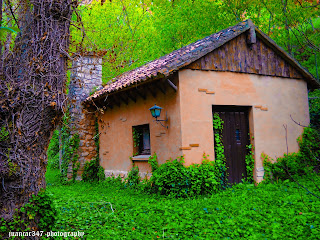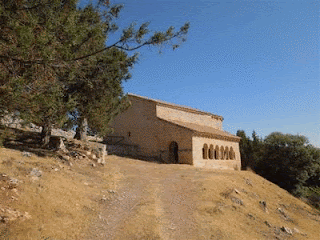Lo idílico y lo sobrenatural / The idyllic and the supernatural
Podríamos suponer que la Naturaleza, en su infinita
maestría, puede llegar a ser, también, reina y soberana de un transformismo,
que, jugando con la fuerza y los contrastes, consigue elaborar insuperables
escenarios, donde la trampa de lo aparentemente idílico, se convierte en la
puerta de entrada de los terrores de lo sobrenatural. Esto lo demostró el
director de cine norteamericano, Sam Raimi, cuando, en un escenario similar a
éste, creó, para un público hambriento de novedades metafísicas, una película
de terror, convertida en una obra de culto con el paso de los años: ‘Posesión
infernal’.
Como digo, en un lugar similar a éste, Raimi, en su película, volvió a sacar, de su aparente ostracismo, los terrores y pesadillas consignadas en la obra de uno de los más prolíficos escritores de terror del siglo XX: H.P. Lovecraft. Idílica a la luz del día, la solitaria cabaña se convierte, por la noche, en un metafórico atanor de lo sobrenatural, auxiliado por los espeluznantes conjuros de un libro maldito, el ‘Necronomicón’, que, paradójicamente, mucha gente considera real. También el entorno, como en la película, se presta al juego de la sugestión, pues, en las proximidades, un pequeño lago, el del ‘Espejo’, sirve de marco para un tenebroso picacho, que, desde el alba de los tiempos y de manera similar a la elegida por Steven Spielberg para sus ‘Contactos en la Tercera Fase’, arrastra tras de sí una leyenda negra: del ‘Diablo’.
We could
suppose that Nature, in its infinite mastery, can also become the queen and
sovereign of a transformism, which, playing with strength and contrasts,
manages to create insurmountable scenarios, where the trap of the apparently
idyllic becomes at the gateway to the terrors of the supernatural. This was
demonstrated by the American film director, Sam Raimi, when, in a scenario
similar to this one, he created, for an audience hungry for metaphysical
novelties, a horror film, which became a cult work over the years: ' Infernal
possession'.
As I say,
in a place similar to this, Raimi, in his film, once again brought out, from
his apparent ostracism, the terrors and nightmares recorded in the work of one
of the most prolific horror writers of the 20th century: H.P. Lovecraft.
Idyllic in the light of day, the solitary cabin becomes, at night, a
metaphorical athanor of the supernatural, aided by the spooky spells of a
cursed book, the 'Necronomicon', which, paradoxically, many people consider
real. The environment, as in the film, also lends itself to the game of
suggestion, since, nearby, a small lake, the 'Mirror' lake, serves as a setting
for a dark peak, which, since the dawn of time and In a similar way to the one
chosen by Steven Spielberg for his 'Contacts in the Third Phase', it drags behind
it a black legend: of the 'Devil'.
AVISO: Tanto el texto, como las fotografías que lo
acompañan, son de mi exclusiva propiedad intelectual y por lo tanto, están
sujetos a mis Derechos de Autor.
NOTICE:
Both the text and the accompanying photographs are my exclusive intellectual
property and are therefore subject to my Copyright.








Comentarios